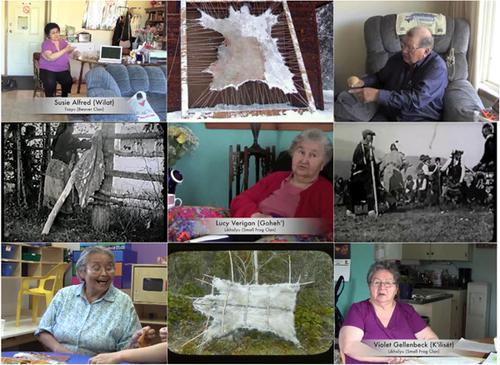当前位置:
X-MOL 学术
›
Can. Geogr.
›
论文详情
Our official English website, www.x-mol.net, welcomes your feedback! (Note: you will need to create a separate account there.)
Remixed methodologies in community‐based film research
The Canadian Geographer ( IF 1.482 ) Pub Date : 2020-08-12 , DOI: 10.1111/cag.12641 Tyler McCreary 1 , Ann Marie F. Murnaghan 2
The Canadian Geographer ( IF 1.482 ) Pub Date : 2020-08-12 , DOI: 10.1111/cag.12641 Tyler McCreary 1 , Ann Marie F. Murnaghan 2
Affiliation

|
This paper explores how remixed methodologies can inform research in Indigenous communities using short films, combining archival and contemporary footage. Drawing on the lineages of Indigenous and feminist community‐based research methodologies, we develop a three‐part conception of remixed methodologies. We emphasize, first, the need to resituate the process of knowledge production within relationships between researchers and Indigenous community members. Second, we stress the importance of reconsidering the intended outputs of community‐university collaboration to centre community goals. Third, we underscore how remixed methodologies can disrupt the narratives surrounding settler colonial archival resources, resituating historical footage with relation to contemporary Indigenous contexts. We apply this framework to our collaborative work with the Witsuwit'en Cultural and Language Authority and the Office of Aboriginal Education at British Columbia School District #54, combining archival and contemporary films to create Indigenous education resources. Specifically, we remixed footage of Witsuwit'en traditional activities from two 1927 National Museum of Canada films with contemporary interviews and footage of Witsuwit'en governance and land use activities. We highlight how making archival films relevant to contemporary Indigenous community goals required disrupting the conventions of scholarly authority, designing collaborative outputs to suit community aims, and resituating knowledge production within the context of Witsuwit'en resilience in the face of colonialism.
中文翻译:

基于社区的电影研究中的混合方法
本文探讨了结合档案和当代素材的混合方法如何利用短片为土著社区的研究提供信息。借鉴土著和女权主义社区研究方法的血统,我们提出了由三部分组成的混合方法论概念。首先,我们强调必须在研究人员与土著社区成员之间的关系中重新定位知识生产的过程。其次,我们强调必须重新考虑社区与大学合作的预期产出,以社区目标为中心。第三,我们强调重新混合的方法论如何破坏围绕定居者殖民档案资源的叙述,重新定位与当代土著背景相关的历史镜头。我们将此框架应用于与Witsuwit'en文化和语言管理局以及不列颠哥伦比亚省学区#54的原住民教育办公室的合作工作中,将档案影片和当代电影结合起来,创造了土著教育资源。具体来说,我们将两幅1927年加拿大国家博物馆电影中Witsuwit'en传统活动的镜头与当代访谈以及Witsuwit'en治理和土地使用活动的镜头混合在一起。我们重点介绍了如何制作与当代土著社区目标相关的档案电影,需要破坏学术权威的惯例,设计适合社区目标的协作输出,并在面对殖民主义的维苏威恩式韧性背景下恢复知识生产。zh_CN文化和语言管理局和不列颠哥伦比亚省学区#54的原住民教育办公室,将档案电影和当代电影结合起来以创建土著教育资源。具体来说,我们将两幅1927年加拿大国家博物馆电影中Witsuwit'en传统活动的镜头与当代访谈以及Witsuwit'en治理和土地使用活动的镜头混合在一起。我们着重介绍如何制作与当代土著社区目标相关的档案电影需要破坏学术权威的惯例,设计适合社区目标的协作输出,并在面对殖民主义的维索维特人恢复力的背景下恢复知识生产。zh_CN文化和语言管理局和不列颠哥伦比亚省学区#54的原住民教育办公室,将档案电影和当代电影结合起来以创建土著教育资源。具体来说,我们将两幅1927年加拿大国家博物馆电影中Witsuwit'en传统活动的镜头与当代访谈以及Witsuwit'en治理和土地使用活动的镜头混合在一起。我们重点介绍了如何制作与当代土著社区目标相关的档案电影,需要破坏学术权威的惯例,设计适合社区目标的协作输出,并在面对殖民主义的维苏威恩式韧性背景下恢复知识生产。将档案电影和当代电影结合起来,以创造土著教育资源。具体来说,我们将两幅1927年加拿大国家博物馆电影中Witsuwit'en传统活动的镜头与当代访谈以及Witsuwit'en治理和土地使用活动的镜头混合在一起。我们重点介绍了如何制作与当代土著社区目标相关的档案电影,需要破坏学术权威的惯例,设计适合社区目标的协作输出,并在面对殖民主义的维苏威恩式韧性背景下恢复知识生产。将档案电影和当代电影结合起来,以创造土著教育资源。具体来说,我们将两幅1927年加拿大国家博物馆电影中Witsuwit'en传统活动的镜头与当代访谈以及Witsuwit'en治理和土地使用活动的镜头混合在一起。我们重点介绍了如何制作与当代土著社区目标相关的档案电影,需要破坏学术权威的惯例,设计适合社区目标的协作输出,并在面对殖民主义的维苏威恩式韧性背景下恢复知识生产。进行治理和土地使用活动。我们重点介绍了如何制作与当代土著社区目标相关的档案电影,需要破坏学术权威的惯例,设计适合社区目标的协作输出,并在面对殖民主义的维苏威恩式韧性背景下恢复知识生产。进行治理和土地使用活动。我们重点介绍了如何制作与当代土著社区目标相关的档案电影,需要破坏学术权威的惯例,设计适合社区目标的协作输出,并在面对殖民主义的维苏威恩式韧性背景下恢复知识生产。
更新日期:2020-08-12
中文翻译:

基于社区的电影研究中的混合方法
本文探讨了结合档案和当代素材的混合方法如何利用短片为土著社区的研究提供信息。借鉴土著和女权主义社区研究方法的血统,我们提出了由三部分组成的混合方法论概念。首先,我们强调必须在研究人员与土著社区成员之间的关系中重新定位知识生产的过程。其次,我们强调必须重新考虑社区与大学合作的预期产出,以社区目标为中心。第三,我们强调重新混合的方法论如何破坏围绕定居者殖民档案资源的叙述,重新定位与当代土著背景相关的历史镜头。我们将此框架应用于与Witsuwit'en文化和语言管理局以及不列颠哥伦比亚省学区#54的原住民教育办公室的合作工作中,将档案影片和当代电影结合起来,创造了土著教育资源。具体来说,我们将两幅1927年加拿大国家博物馆电影中Witsuwit'en传统活动的镜头与当代访谈以及Witsuwit'en治理和土地使用活动的镜头混合在一起。我们重点介绍了如何制作与当代土著社区目标相关的档案电影,需要破坏学术权威的惯例,设计适合社区目标的协作输出,并在面对殖民主义的维苏威恩式韧性背景下恢复知识生产。zh_CN文化和语言管理局和不列颠哥伦比亚省学区#54的原住民教育办公室,将档案电影和当代电影结合起来以创建土著教育资源。具体来说,我们将两幅1927年加拿大国家博物馆电影中Witsuwit'en传统活动的镜头与当代访谈以及Witsuwit'en治理和土地使用活动的镜头混合在一起。我们着重介绍如何制作与当代土著社区目标相关的档案电影需要破坏学术权威的惯例,设计适合社区目标的协作输出,并在面对殖民主义的维索维特人恢复力的背景下恢复知识生产。zh_CN文化和语言管理局和不列颠哥伦比亚省学区#54的原住民教育办公室,将档案电影和当代电影结合起来以创建土著教育资源。具体来说,我们将两幅1927年加拿大国家博物馆电影中Witsuwit'en传统活动的镜头与当代访谈以及Witsuwit'en治理和土地使用活动的镜头混合在一起。我们重点介绍了如何制作与当代土著社区目标相关的档案电影,需要破坏学术权威的惯例,设计适合社区目标的协作输出,并在面对殖民主义的维苏威恩式韧性背景下恢复知识生产。将档案电影和当代电影结合起来,以创造土著教育资源。具体来说,我们将两幅1927年加拿大国家博物馆电影中Witsuwit'en传统活动的镜头与当代访谈以及Witsuwit'en治理和土地使用活动的镜头混合在一起。我们重点介绍了如何制作与当代土著社区目标相关的档案电影,需要破坏学术权威的惯例,设计适合社区目标的协作输出,并在面对殖民主义的维苏威恩式韧性背景下恢复知识生产。将档案电影和当代电影结合起来,以创造土著教育资源。具体来说,我们将两幅1927年加拿大国家博物馆电影中Witsuwit'en传统活动的镜头与当代访谈以及Witsuwit'en治理和土地使用活动的镜头混合在一起。我们重点介绍了如何制作与当代土著社区目标相关的档案电影,需要破坏学术权威的惯例,设计适合社区目标的协作输出,并在面对殖民主义的维苏威恩式韧性背景下恢复知识生产。进行治理和土地使用活动。我们重点介绍了如何制作与当代土著社区目标相关的档案电影,需要破坏学术权威的惯例,设计适合社区目标的协作输出,并在面对殖民主义的维苏威恩式韧性背景下恢复知识生产。进行治理和土地使用活动。我们重点介绍了如何制作与当代土著社区目标相关的档案电影,需要破坏学术权威的惯例,设计适合社区目标的协作输出,并在面对殖民主义的维苏威恩式韧性背景下恢复知识生产。


























 京公网安备 11010802027423号
京公网安备 11010802027423号